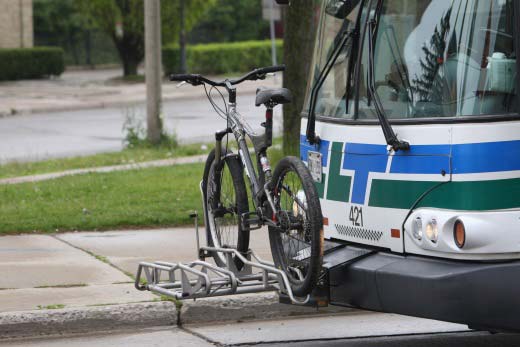What encourages active transportation?
In general, the following features encourage the use of active transportation:
- Compact mix of land uses (services and destinations located close to each other)
- Housing density with a variety of housing options
- Connections to places where people want to go
- Defined walking and cycling routes
- Sidewalks and multi-use pathways
- Cycling facilities (bicycle lanes, bicycle parking)
- Reduced speed limits
- Traffic calming measures (speed humps, road narrowing)
- Convenient public transit service 2
Specific design measures and strategies play a key role in supporting active transportation:
Complete Streets
Complete streets put people first by being designed for all ages, abilities and modes of travel. Complete streets provide safe and comfortable access for:
- pedestrians
- cyclists
- public transit users
- mobility impaired individuals
- motorists 4
Learn more about complete streets: London Complete Streets Design Manual
Smart Growth America found that complete streets:
- increased walking and cycling
- increased public transit trips
- reduced automobile trips
- reduced collisions and injuries
- increased employment levels
- increased numbers of new businesses
- increased property values 5
Connectivity
Having a community that is well connected to places where people want to travel supports walking, cycling and public transit use.
Having a high number of intersections in a given area provides more route options from which people can choose. By providing easy access to a variety of safe, direct and alternative routes between destinations, people are more likely to choose active modes of travel.
A well connected community, where people use active transportation, results in reduced motor vehicle use and provides environmental and health benefits such as:
- improved air quality
- reduced greenhouse gas emissions
- reduced impact on climate change
- improved respiratory and cardiovascular health 6, 7, 8
Attractive Environments
People are more likely to use active transportation when routes are attractive, safe for travel and include features such as:
- pleasant streetscapes (trees, plants, street furniture, lighting)
- routes and destinations that are both functional and fun (services, shopping, recreation)
- high quality public spaces (parks, pedestrian plazas, art / cultural features)
Road Safety
Use of active transportation is increased when road safety is improved for all road users, especially pedestrians and cyclists. Improved road safety is accomplished by combining road safety strategies such as:
- Engineering - physical design and layout of transportation infrastructure
- Education - information on how to use transportation infrastructure with various types of transportation options, i.e. walking, cycling, driving, etc.
- Enforcement - laws that promote safe travel for all modes of transportation
Examples of road safety measures that support active transportation include:
- sidewalks, multi-use pathways
- reduced speed limits
- traffic calming measures (speed humps, road narrowing)
- various types of pedestrian and cycling facilities (safety islands, traffic control signals, signage, road markings, raised / buffered / protected facilities)
Research indicates that when there are increased numbers of people walking and cycling that motorist behaviour changes such that safety is improved.9

